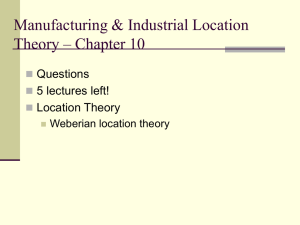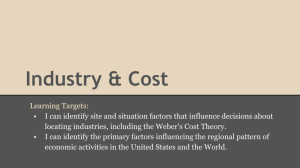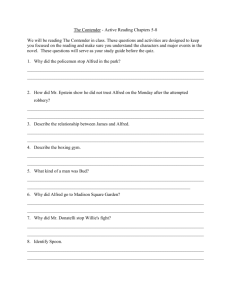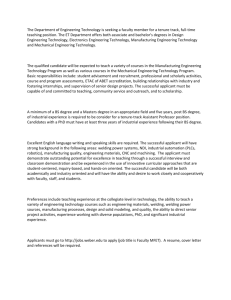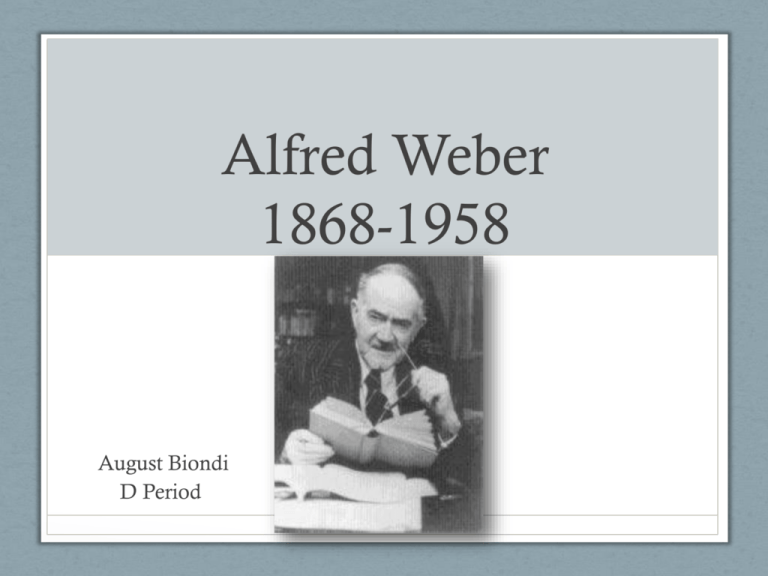
Alfred Weber
1868-1958
August Biondi
D Period
Alfred Weber
•
Early Life
-
Born in Erfurt, Germany (Prussian Saxony)
-
Raised in Charlottenburg, Germany
-
Second of seven children
•
Influences
-
His father was a politician (city magistrate). Prominent scholars and
public figures were constantly influencing him.
•
Education
-
Attended University of Berlin
-
Obtained his doctorate in 1895
-
Was a professor at the University of Heidelberg for the majority of his
career
-
He was an economist, then became a sociologist
Least Cost Theory (1909)
“Theory of Industrial Location”
• Describes how/where to find the optimal location for a
manufacturing firm. Its purpose it to place a firm in a location
where the final cost of transportation, labor, and materials are
minimized.
• A firm is located where costs are the least.
• A firm is placed in relation to raw materials and the market.
Least Cost Theory
Three Catergories of Cost:
• Transportation- best site is where the cost to transport raw
materials and finished product is the lowest
• Labor- high labor costs reduce profit. Locations that offer
cheap, non-union labor make up for transportation costs
• Agglomeration- when a group of
industries collaborate for mutual benefits
(services, facilities). Can lower costs
- Deglomeration- occurs when
companies/services leave because of over
concentration of industries
Least- Cost Theory
Weight- Losing Case
Weight- Gaining Case
• Weight of final product is
less than the weight of the
raw materials
• Weight of the final product
is heavier than the raw
materials
• For this case it is best if the
firm is located near the
source
• For this case it is best if the
firm is located near the
market
Least Cost Theory
Weight-Losing Case
Weight- Gaining Case
ACTIVITY:
Determine where the firm goes based on the cost scenario
by placing the firm in the optimal location.
Weight Losing Case
Weight Gaining Case
Firms:
Market
Raw Material
Market
Raw Material
For Further Information
CHAPTER 11
- Pages 350-368
Discusses:
Industry Distribution
- Industrial Regions
Situation Factors
- Proximity to markets, inputs, and when to use different
transportation types
Importance of Site Factors
- Labor
Land and Location Factors
- Rural, environmental, capital
Bibliography
•
"Alfred Weber's Theory of Industrial Location." Alfred Weber's Theory of Industrial Location. Pinterest.
Web. 15 Sept. 2015. <http://teacherweb.ftl.pinecrest.edu/snyderd/APHG/Unit%207/weber.htm>.
•
"Alfred Weber." Wikipedia. Wikimedia Foundation, 17 May 2015. Web. 15 Sept. 2015.
<https://en.wikipedia.org/wiki/Alfred_Weber>.
•
"CSISS Classics - Alfred Weber: Theory of the Location of Industries, 1909." CSISS Classics - Alfred
Weber: Theory of the Location of Industries, 1909. Web. 14 Sept. 2015.
http://www.csiss.org/classics/content/51.
•
Gale, Thomas. "Weber, Alfred." Encyclopedia.com. HighBeam Research, 01 Jan. 1968. Web. 15 Sept.
2015. <http://www.encyclopedia.com/topic/Alfred_Weber.aspx>.
•
Rubenstein, James M. The Cultural Landscape: An Introduction to Human Geography. Upper Saddle
River, NJ: Pearson/Prentice Hall, 2005. Print.
Images:
•
•
•
•
http://www.csiss.org/classics/uploads/df-alfred%20weber.jpg
http://egg-humangeography.weebly.com/uploads/2/0/5/0/20502018/1369791596.jpg
http://egg-humangeography.weebly.com/uploads/2/0/5/0/20502018/1369791493.jpg
http://teacherweb.ftl.pinecrest.edu/snyderd/APHG/Unit%207/images/weber.7.gif


